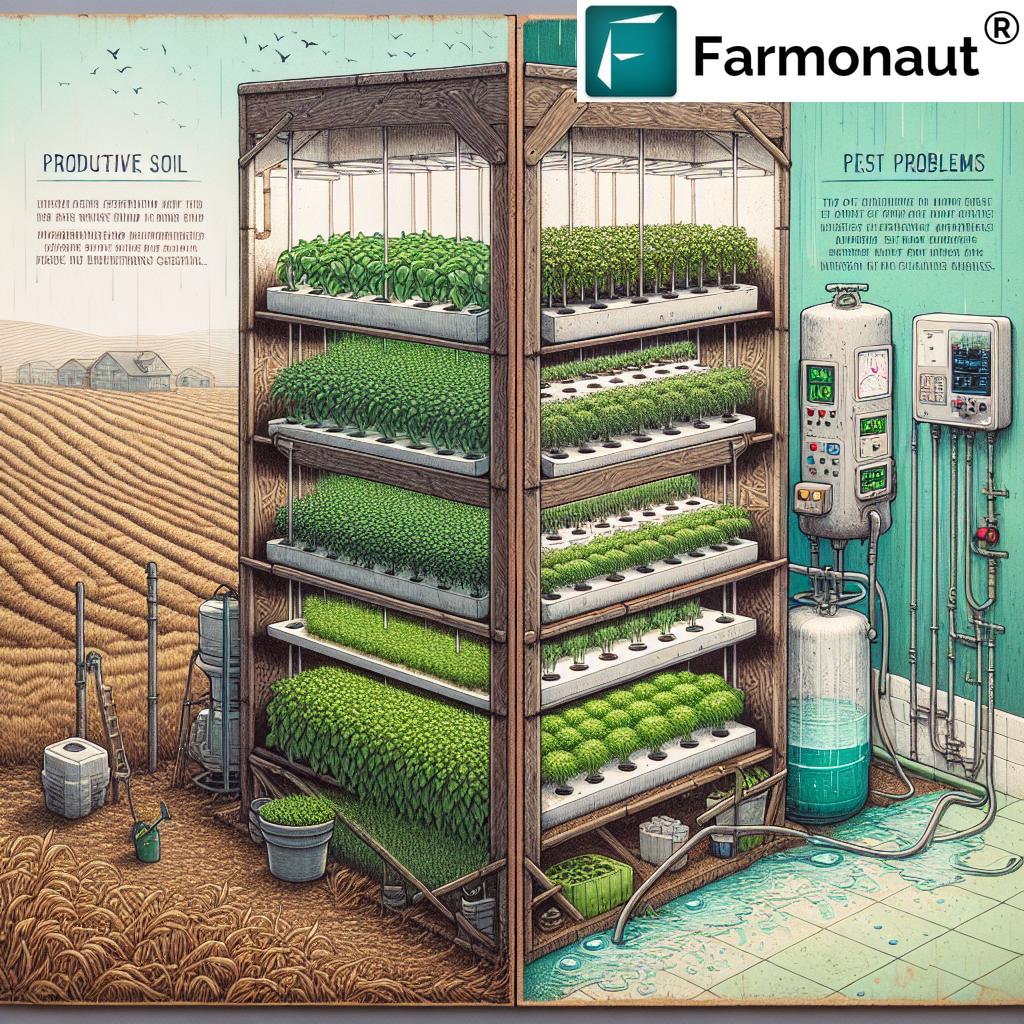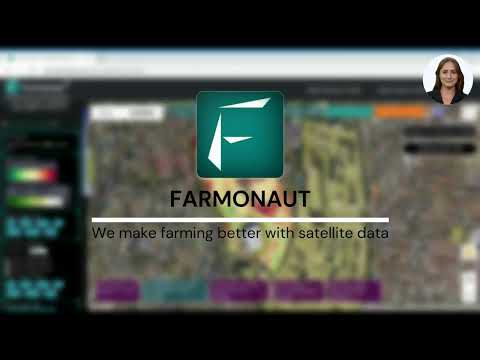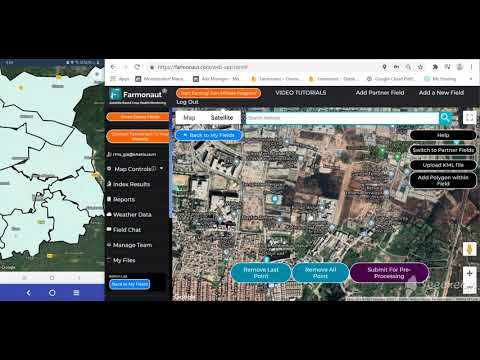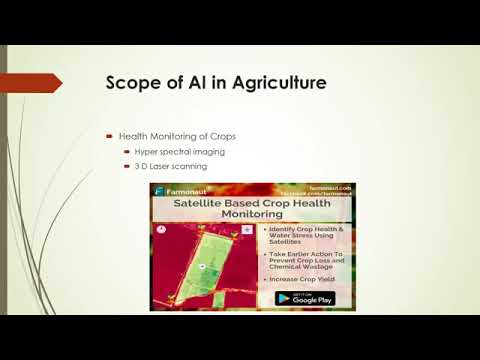Sustainable Hydroponics: Revolutionizing Year-Round Farming in Idaho’s Greenhouses
“Hydroponic systems can reduce water usage by up to 90% compared to traditional soil-based farming methods.”
Welcome to the future of farming! We’re excited to explore the innovative world of hydroponics and how it’s transforming agriculture in Idaho and beyond. As we delve into this fascinating topic, we’ll uncover the benefits of hydroponic farming, learn how to start your own sustainable indoor garden, and discover why this method is becoming increasingly popular for year-round food production.
What is Hydroponics?
Hydroponics is a soil-less farming technique that uses nutrient-rich water to grow plants. This method allows for precise control over the growing environment, resulting in faster growth rates, higher yields, and more efficient use of resources. In Idaho, where the growing season can be limited by harsh winters, hydroponics offers a revolutionary solution for year-round farming.

The Benefits of Hydroponic Farming
Hydroponic farming offers numerous advantages over traditional soil-based agriculture. Let’s explore some of the key benefits:
- Water Efficiency: Hydroponics uses up to 90% less water than conventional farming methods, making it an excellent choice for water-scarce regions.
- Year-Round Production: Indoor hydroponic systems allow for continuous crop growth, regardless of external weather conditions.
- Space Optimization: Vertical hydroponic setups can produce more food in smaller areas, making it ideal for urban environments.
- Reduced Pest and Disease Pressure: The controlled environment of hydroponic systems significantly reduces the need for pesticides and minimizes disease outbreaks.
- Faster Growth Rates: Plants grown hydroponically often mature 30-50% faster than their soil-grown counterparts.
- Consistent Quality: With precise control over nutrients and environmental factors, hydroponic crops tend to be of consistently high quality.
These benefits make hydroponics an attractive option for both small-scale home gardeners and commercial farmers looking to maximize productivity and sustainability.
Getting Started with Hydroponics at Home
If you’re intrigued by the possibilities of hydroponic farming, you’ll be pleased to know that starting your own system at home is both achievable and rewarding. Here’s a step-by-step guide to help you get started:
- Choose Your System: There are several types of hydroponic systems, including Deep Water Culture (DWC), Nutrient Film Technique (NFT), and Ebb and Flow. Research each to find the best fit for your space and needs.
- Select Your Crops: Start with easy-to-grow plants like lettuce, herbs, or tomatoes. These crops adapt well to hydroponic conditions and have shorter growth cycles.
- Gather Supplies: You’ll need grow lights, a water pump, air stones, growing media, and hydroponic nutrients. Many online retailers offer complete starter kits.
- Set Up Your Growing Area: Choose a location with access to electricity and water. Ensure the area can maintain a consistent temperature between 60-75°F (15-24°C).
- Prepare Your Nutrient Solution: Mix your hydroponic nutrients according to the manufacturer’s instructions. Remember, different plants may require different nutrient ratios.
- Plant Your Crops: Transfer your seedlings or seeds into the hydroponic system, ensuring they have adequate support and access to the nutrient solution.
- Monitor and Maintain: Regularly check pH levels, nutrient concentrations, and water temperature. Adjust as needed to keep your plants healthy.
By following these steps, you can create a thriving hydroponic garden in your own home, enjoying fresh produce year-round.
Hydroponic Greenhouse Setups: A Closer Look
For those looking to scale up their hydroponic operations, greenhouse setups offer an excellent solution. Greenhouses provide additional control over environmental factors while still allowing for natural sunlight. Here’s what you need to know about hydroponic greenhouse setups:
- Climate Control: Greenhouses allow for precise temperature and humidity management, creating optimal growing conditions for your crops.
- Lighting: While natural sunlight is available, supplemental lighting can extend growing hours and improve crop yields.
- Vertical Space Utilization: Many hydroponic greenhouse systems use vertical growing techniques to maximize space efficiency.
- Automated Systems: Large-scale operations often incorporate automated nutrient delivery, climate control, and monitoring systems for increased efficiency.
Greenhouse hydroponics combines the benefits of controlled environment agriculture with the sustainability of soil-less farming, making it an attractive option for commercial growers.
Nutrient Management in Hydroponic Systems
One of the key aspects of successful hydroponic farming is proper nutrient management. Unlike traditional soil-based farming, hydroponic systems require careful balance and monitoring of nutrient solutions. Here’s what you need to know:
- Essential Nutrients: Plants require macronutrients (nitrogen, phosphorus, potassium) and micronutrients (iron, manganese, zinc, etc.) for healthy growth.
- pH Levels: Most hydroponic crops thrive in a slightly acidic environment with a pH between 5.5 and 6.5. Regular monitoring and adjustment are crucial.
- Electrical Conductivity (EC): EC measurements help gauge the concentration of nutrients in your solution. Different crops have different EC requirements.
- Water Quality: Start with clean, filtered water to ensure your plants receive only the nutrients you intend to provide.
Proper nutrient management is essential for maximizing crop yields and maintaining plant health in hydroponic systems.
“Hydroponic greenhouses can produce crops up to 3 times faster than conventional farming, enabling year-round harvests.”
Crop Selection for Hydroponic Farming
While many crops can be grown hydroponically, some are particularly well-suited to this method of cultivation. Here are some popular choices for hydroponic farming:
- Leafy Greens: Lettuce, spinach, kale, and Swiss chard are fast-growing and adapt well to hydroponic systems.
- Herbs: Basil, mint, cilantro, and parsley thrive in hydroponic environments and are in high demand year-round.
- Tomatoes: Indeterminate tomato varieties can produce fruit continuously in hydroponic setups.
- Peppers: Both sweet and hot peppers perform well in hydroponic systems, offering high yields in compact spaces.
- Cucumbers: Vertical hydroponic systems are ideal for growing cucumbers, maximizing space efficiency.
When selecting crops for your hydroponic system, consider market demand, growth rates, and the specific requirements of each plant species.

Sustainability in Hydroponic Farming
Hydroponic farming aligns well with sustainable agriculture practices. Here’s how this innovative method contributes to environmental conservation:
- Water Conservation: Hydroponic systems use significantly less water than traditional farming methods, making them ideal for water-scarce regions.
- Reduced Land Use: Vertical hydroponic setups can produce more food in smaller areas, preserving natural habitats and reducing deforestation.
- Minimal Soil Degradation: Since hydroponics doesn’t rely on soil, it helps preserve this valuable resource and prevents soil erosion.
- Decreased Carbon Footprint: Local hydroponic production reduces the need for long-distance transportation, lowering overall carbon emissions.
- Pesticide Reduction: The controlled environment of hydroponic systems naturally reduces pest pressure, minimizing or eliminating the need for chemical pesticides.
For those interested in monitoring and reducing their environmental impact, Farmonaut’s carbon footprinting tool can be an invaluable resource. This innovative solution helps agribusinesses track their carbon emissions in real-time, enabling them to make data-driven decisions towards more sustainable practices.
Overcoming Challenges in Hydroponic Farming
While hydroponics offers numerous benefits, it’s important to be aware of potential challenges:
- Initial Setup Costs: Hydroponic systems can require a significant upfront investment in equipment and infrastructure.
- Technical Knowledge: Successful hydroponic farming requires understanding of plant nutrition, water chemistry, and environmental control.
- Power Dependency: Most hydroponic systems rely on electricity for pumps, lighting, and climate control. Backup power sources may be necessary.
- Risk of System Failures: Issues like pump malfunctions or power outages can quickly affect plant health if not addressed promptly.
- Limited Crop Variety: While many crops can be grown hydroponically, some plants are better suited to this method than others.
By being aware of these challenges and planning accordingly, hydroponic farmers can mitigate risks and maximize the benefits of this innovative farming method.
The Future of Hydroponics in Urban Agriculture
As urban populations continue to grow, the demand for locally-produced, fresh food is increasing. Hydroponics is poised to play a crucial role in urban agriculture, offering several advantages:
- Vertical Farming: Hydroponic systems can be stacked vertically, maximizing food production in limited urban spaces.
- Rooftop Gardens: Lightweight hydroponic systems are ideal for rooftop installations, turning unused urban spaces into productive gardens.
- Year-Round Production: Indoor hydroponic farms can produce fresh food continuously, regardless of outdoor weather conditions.
- Reduced Transportation Costs: Urban hydroponic farms can provide fresh produce directly to local markets, reducing transportation costs and carbon emissions.
- Educational Opportunities: Urban hydroponic farms can serve as educational centers, teaching communities about sustainable food production.
For those interested in large-scale urban farming initiatives, Farmonaut’s large-scale farm management solution offers powerful tools for monitoring and optimizing hydroponic operations. This platform can help urban farmers maximize productivity while ensuring sustainable resource use.
Comparing Traditional and Hydroponic Farming
To better understand the advantages of hydroponic farming, let’s compare it with traditional soil-based agriculture:
| Farming Aspect | Traditional Farming | Hydroponic Farming | Sustainability Impact |
|---|---|---|---|
| Water Usage (gal/lb produce) | 20-30 | 1-3 | Significant water conservation |
| Land Requirement (sq ft/lb produce) | 3-4 | 0.5-1 | Reduced land use, habitat preservation |
| Pesticide Use | Frequent | Minimal to none | Reduced chemical pollution |
| Year-round Production | No (seasonal) | Yes | Increased food security |
| Nutrient Efficiency | 40-60% | 80-90% | Reduced nutrient runoff |
| Crop Yield (lb/sq ft) | 0.5-1 | 2-5 | Increased food production efficiency |
| Energy Consumption (kWh/lb produce) | 0.1-0.3 | 0.5-1.5 | Higher energy use, potential for renewable integration |
This comparison highlights the significant advantages of hydroponic farming in terms of resource efficiency and environmental impact. While energy consumption can be higher in hydroponic systems, the overall sustainability benefits are substantial.
The Role of Technology in Hydroponic Farming
Advancements in technology are playing a crucial role in enhancing the efficiency and productivity of hydroponic farming. Here are some key technological innovations:
- IoT Sensors: Internet of Things (IoT) devices can monitor and control various aspects of hydroponic systems, including nutrient levels, pH, temperature, and humidity.
- AI and Machine Learning: Artificial Intelligence algorithms can analyze data from hydroponic systems to optimize growing conditions and predict potential issues.
- Automated Nutrient Delivery: Advanced systems can automatically adjust nutrient solutions based on real-time plant needs.
- LED Lighting: Energy-efficient LED grow lights can be tailored to specific crop requirements, optimizing photosynthesis and growth rates.
- Robotics: Automated harvesting and planting systems are being developed to reduce labor costs and increase efficiency in large-scale hydroponic operations.
For farmers looking to leverage technology in their hydroponic operations, Farmonaut’s crop plantation and forest advisory services offer cutting-edge solutions. These services utilize satellite imagery and AI to provide personalized recommendations for optimizing crop health and yield.
Economic Viability of Hydroponic Farming
While the initial setup costs for hydroponic systems can be higher than traditional farming methods, the long-term economic benefits are significant:
- Higher Yields: Hydroponic systems can produce up to 3-10 times more crops per acre than traditional farming.
- Year-Round Production: Continuous harvests mean steady income throughout the year.
- Premium Pricing: Many consumers are willing to pay more for locally-grown, pesticide-free hydroponic produce.
- Reduced Labor Costs: Automated hydroponic systems can significantly reduce labor requirements.
- Lower Transportation Costs: Urban hydroponic farms can supply local markets directly, reducing transportation expenses.
For those considering the financial aspects of hydroponic farming, Farmonaut’s crop loan and insurance services can provide valuable support. These services offer satellite-based verification for crop loans and insurance, helping farmers access financial resources while mitigating risks.
Hydroponic Farming Success Stories
Across Idaho and beyond, farmers are experiencing success with hydroponic systems. Let’s look at some inspiring examples:
- GreenWave Hydroponics: Located in Fruitland, Idaho, this farm has been successfully growing a variety of greens and herbs since 2021. Owner Amos Wengerd reports significant water savings and pesticide-free production.
- Urban Vertical Farms: In cities like Boise, innovative farmers are utilizing vertical hydroponic systems to produce fresh vegetables in converted warehouses, supplying local restaurants and markets.
- Community Supported Agriculture (CSA) Programs: Several hydroponic farms in Idaho have successfully implemented CSA programs, providing subscribers with regular deliveries of fresh, locally-grown produce.
These success stories demonstrate the viability and potential of hydroponic farming in various contexts, from rural areas to urban centers.
Frequently Asked Questions
Here are some common questions about hydroponic farming:
- Q: Is hydroponic produce organic?
A: While hydroponic produce is often grown without pesticides, it’s not typically certified organic due to the lack of soil. However, many consider it equally or more sustainable than traditional organic farming. - Q: How does the taste of hydroponic produce compare to soil-grown?
A: Many people find that hydroponic produce tastes just as good, if not better, than soil-grown produce due to optimal growing conditions and harvesting at peak ripeness. - Q: Can all crops be grown hydroponically?
A: While many crops can be grown hydroponically, some are more suited to this method than others. Leafy greens, herbs, tomatoes, and peppers are particularly well-adapted to hydroponic systems. - Q: How much space do I need for a home hydroponic system?
A: Home hydroponic systems can be as small as a countertop unit or as large as a dedicated greenhouse. Many people successfully grow hydroponic plants in spare rooms, basements, or garages. - Q: Is hydroponic farming more expensive than traditional farming?
A: While initial setup costs can be higher, hydroponic farming often results in lower ongoing costs due to reduced water usage, fewer pest problems, and higher yields in smaller spaces.
Conclusion: The Future of Farming is Here
As we’ve explored throughout this article, hydroponic farming represents a significant leap forward in sustainable agriculture. From water conservation to year-round production, the benefits of this innovative farming method are clear. Whether you’re a home gardener looking to grow fresh herbs in your kitchen or a commercial farmer aiming to maximize yields, hydroponics offers exciting possibilities.
In Idaho and beyond, hydroponic farming is revolutionizing the way we think about food production. By embracing this technology, we can move towards a more sustainable, efficient, and food-secure future. As climate change and population growth continue to put pressure on our food systems, hydroponics stands out as a promising solution to many of the challenges we face.
We encourage you to explore the world of hydroponics further. Whether you’re starting a small home system or considering a large-scale commercial operation, the resources and technologies available today make it easier than ever to get started. Remember, every step towards sustainable farming is a step towards a healthier planet and a more secure food future for all.
For those looking to take their hydroponic farming to the next level, consider exploring the advanced agricultural solutions offered by Farmonaut. From satellite-based crop monitoring to AI-driven advisory services, these cutting-edge tools can help you optimize your hydroponic operations and achieve greater success in sustainable farming.
Let’s embrace the future of farming together, one hydroponic system at a time!
Explore Farmonaut’s Agricultural Solutions
Ready to take your farming to the next level? Discover how Farmonaut’s advanced agricultural technologies can help you optimize your operations:
Earn With Farmonaut: Join our affiliate program and earn a 20% recurring commission while helping farmers save 10% on our services. Onboard 10 Elite farmers monthly to earn a minimum of $148,000 annually. Start now and grow your income!
Farmonaut Subscriptions







